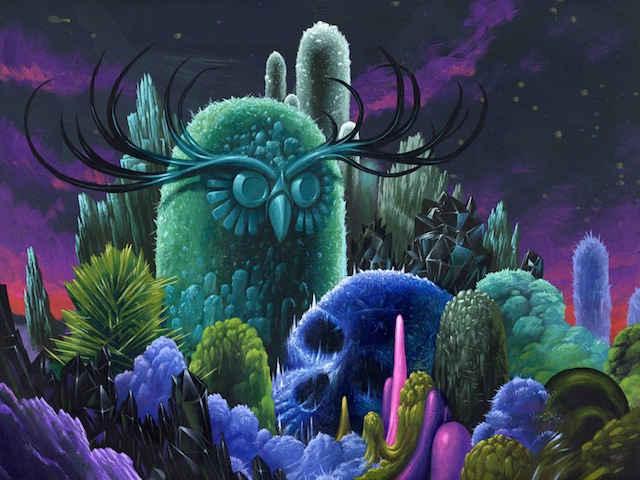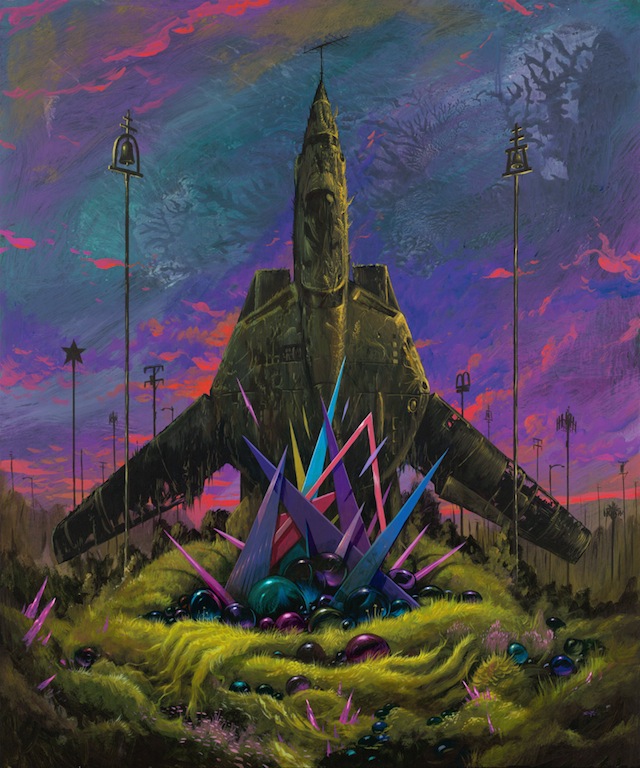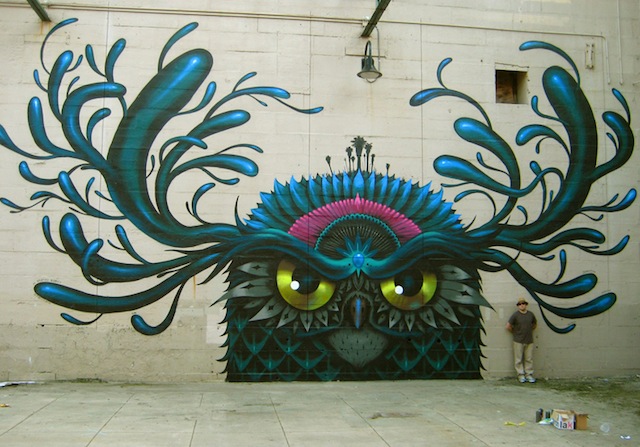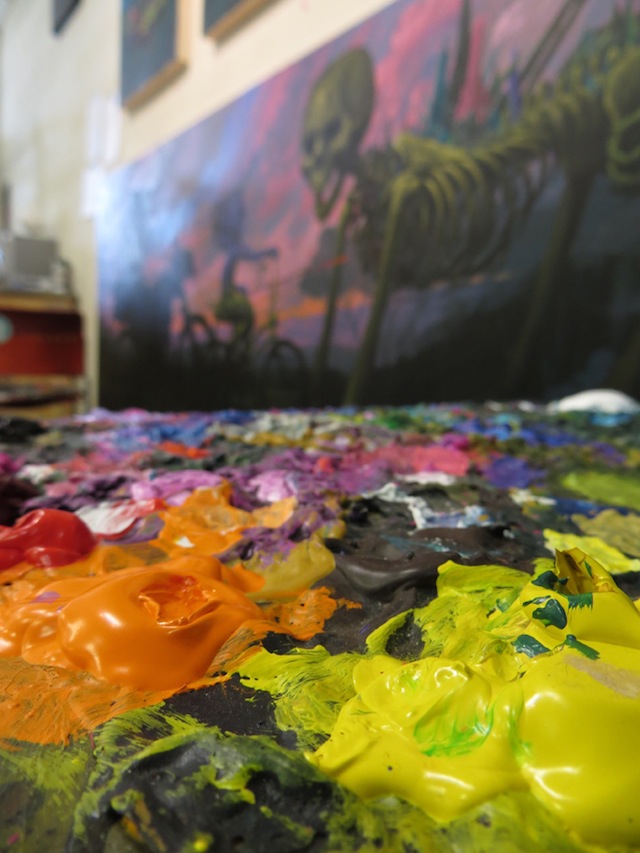
Jeff Soto will be opening his fourth solo show at Jonathan LeVine Gallery on September 8th, alongside the simultaneous solo shows of Audrey Kawasaki and Judith Supine. The show, entitled Decay and Overgrowth, explores life, death and the passage of time. In this interview, Soto tells Vandalog about the emotional journey this past year has taken him on, including the death of two of his grandparents, and how these events provoked his consideration of mortality; which would become a central theme of this show.
V: In your own words, can you tell us about the underlying themes of Decay and Overgrowth?
JS: I started researching my ancestry about seven years ago, well, even before that really. As a kid I knew my grandparents fought in WWII and my grandma would list off all the things we had in us- Irish, Italian, Sioux, Dutch, etc.. These stories were interesting to me. So from an early age I was aware that there is some history there, and at some point a teacher I had showed us family trees. When I was a teenager I saw Norman Rockwell’s family tree painting where the kid’s ancestors were pirates and Native Americans and cowboys. It got me interested in who my ancestors were, and how all my living relatives were related.
The last few years I have researched and got deeper into who these people were. Decay and Overgrowth comes out of this research. Finding all these relatives really drove home the point that we are born, we have kids, get married, live our life and die. And then the kids repeat the same pattern. Our offspring who come into the world like new flowers, growing and flourishing, eventually meet the same fate as any other living thing. We start aging, and at some point we all will die. We turn to dust, go back into the Earth to nourish it, and then the cycle repeats. I don’t see it as morbid at all, and I hope the paintings don’t seem too death obsessed! Even though I’ve unofficially titled my show “The Skull Show”.

V: This is a solo show, but you’re showing at the same time as Audrey Kawasaki’s and Judith Supine’s solo shows. How do you feel like this combination of works either compliment or juxtapose one another?
JS: I respect both of them. I know Audrey a bit but have never met Judith. I think as a whole our work is very different but individually we’re each very strong in what we do. Should be a fun show with something for everyone. I am predicting a large turnout.
V: Was this exploration of mortality more of a catharsis for you or a way of explaining death to your children?
JS: It’s more for me I guess. They’re too young to fully understand death. We do not hide it from them at all, you know, like if one of our fish dies or we find a dead rabbit on a walk, we talk about it. Two of my grandparents passed away in the last year, and they went to the funerals even though they’re young. I never really thought about death because it was not around me. Or maybe it’s an age thing- now that I’m in my mid/late 30’s and I have two kids that depend on me, it’s on my mind. Seeing my little brothers grow up and my parents age has been a trip.

V: What do you think your generation adds to the collective human experience?
JS: I think it’s too early to say. There’s good and bad things we’re going to add. I know that my generation seems more open to cultural differences among people. In the United States, overall we’re less racist than 40 years ago, and I think the next generation will be better than us. There’s still a long way to go but the situation is improving from the Baby Boomers and previous generations.
And of course the internet has made huge changes. For the first time in human history information is easily accessible to most people. It is empowering. Maybe it’s homogenizing us as well. It’s that whole globalization thing, we all buy the same products, listen to the same music and watch the same movies- are cultural differences starting to die out? Technology is good and bad I think. I’m 37, so I grew up with Atari which was fun, but only for about 30 minutes then we’d go outside and build a fort, climb a tree, make up a game… we used our imagination! I think that’s lacking in many kids and I wonder how it will change things. Maybe it already has. I graduated high school right as the internet was going mainstream- 1993. Our school had one computer that was online and the only thing we could access was college libraries in town. We had to search and hunt for our info, we had to go downtown and pour through a ton of books and along the way we would find other interesting books and much more thoroughly researched information. Now all the info is easily and quickly accessed in a nice little five paragraph web page. I do love Wikipedia, but 20 years ago you’d read a 300 page book on say, Cortés, now a kid in high school will read a concise web page on the iPad. Maybe that’s not so bad, I guess the Wiki entry would have much more up to date info… see, technology that this generation is bringing is both good and bad.
V: Elements of nature seem to be a reoccurring feature in your work. What’s your relationship with nature?
JS: We all have the same relationship in that we’re animals. But we’re really smart animals, so we think we’re above everything else, but we are the same. We are “nature” just as much as a giant Sequoia or an ant.
I also paint nature because I want to be OUT in nature instead of painting! The plants and rocks and bugs and the strange animals and clouds you see outside are inspiring.

V: Were you prompted to paint this series after the passing of your grandparents or did your inspiration come from the research that came after their passing?
JS: A little of both. I was already making paintings about the cycle of life because I could see my grandparents age. To me, maybe because I didn’t see them as much as I’d like, it was a dramatic change in just a couple years. It was on my mind that they were approaching the end of their time. I was also seeing my kids growing and changing, in particular my youngest daughter who’s now 3 1/2. It was that vibrant youthfulness juxtaposed with slowly aging that was fascinating to me.
What cemented my concept for this show was my grandfather passing away in April. It was tough for me, I was painting a huge owl mural in Richmond and I was halfway through it when I got the call that he had passed away. I had to work through my emotions and stay up on that scissor lift, I decided to dedicate it to him. I finished that evening after the spectators had left, and the weird thing was that when I got back and sat there alone to see if it was finished, I realized HE was the owl. Grandpa Barney was the great owl, the great loving patriarch of our family and the antler points were the children and grandchildren and great grandchildren he’d left behind. I was filled with emotion as I’d had to hold it in for the whole day and I just started crying… it was like equal parts being happy that he had a good life and we got to experience him and being sad that he was gone. But there was this incredible feeling of hope in spite of losing him. He taught all of us so much. I talked to my wife and kids that night and I felt so positive and also so lonely in my hotel room on the other side of the continent from them. There was about a million emotions going through my head that night and it ended up spawning this group of paintings.

V: How did your commercial with Chevy come about, and what was that experience like?
JS: Wow, I got a little emotional on that last question! So the Sonic commercial… I was contacted by an ad agency. They were pitching an idea to put painting tools in a car and create a mural with it. The original idea had the car doing all the work, but that was proving to be highly expensive, not to mention I wasn’t too excited about my name being attached to work I had no real hand in. We ended up going with three painting tools- a paint sprayer set on a turret, and paint cannon that fired paint projectiles and a heavy duty robotics arm fitted with a spray attachment. We worked for months on it, the robotics guys built the tools and I would fly up to SF to test and help tweak them for painting.
The filming was one of the strangest things I’ve ever been a part of. I never realized so much goes into a commercial and I have a newfound respect for the whole industry. I did all my own driving, except one scene haha… I learned sorta how to drive stick finally!
I did worry needlessly about what the art community and other street artists would think. I had hesitations going into the project- Would people think I was a sell out? How would the commercial depict me? Was it going to turn out cheesy? Would it be a joke? Before I said yes to this project, I thought about it for a few days. I came to the conclusion that I didn’t really give a fuck what people had to say. I owe nothing to the street art world and I don’t limit myself artistically. I saw it as a chance to make some art with a really fun tool. I got to play with robots and fire paint cannons! It was like a childhood fantasy to make a mess with paint and have fun! They didn’t want a big Chevy logo or anything, they wanted me to be myself. In the end, it was a blast, I got paid and my peers were supportive. The directors made it artistic and fun and I loved the commercial. The only criticism was from Ben Eine who dissed the piece in a pretty big way. Cause you know, he keeps it real 24/7, never gets any help or income from anything corporate. He’s so cool! All my graf friends were like “Trek, you gotta battle him now”, but I’m not a graf artist anymore, plus it might be embarrassing for him you know? I think he could have went about it differently, but at the end of the day, it is what it is.
V: Have you considered what you might say if you found out your kids were getting into graffiti?
JS: When you say graffiti I think of the hip hop type of graf, like with crews and tagging and bombing… I will tell them not to get involved with that. I still love looking at it and it’s changed quite a bit over the last 20 years, but it’s still very closed-minded. There’s too many rules. Too much crew politics. Or maybe you mean “graffiti” as just illegal art outside of the hip hop tradition, defacing property like… Neckface. I cringe when I think about my girls as teenagers going around tagging at night! We found ourselves in some very dangerous situations back then. We did it because we were poor, things were hopeless or we were neglected at home. I hope my kids don’t have to experience that. I’d tell them to get into art instead. Get into painting murals.
Photos courtesy of Jeff Soto
